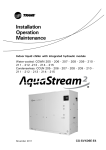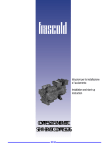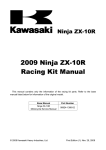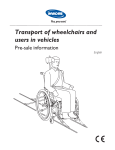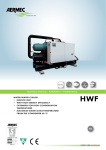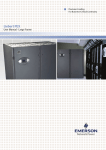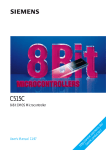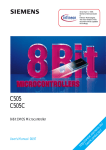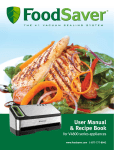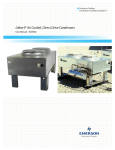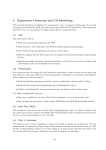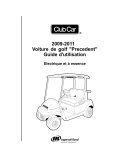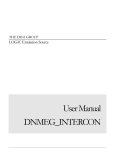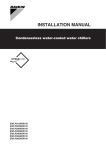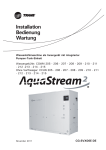Download IOM Manual
Transcript
Installation Operation Maintenance Indoor liquid chiller with integrated hydraulic module Water-cooled: CGWN 205 - 206 - 207 - 208 209 - 210 - 211 - 212 -213 - 214 - 215 Condenserless: CCUN 205 - 206 - 207 - 208 209 - 210 - 211 - 212 - 213 - 214 - 215 CG-SVX06D-E4 Trane Air Conditioning and Refrigeration equipment Environmental Protection / Compliance with F-Gas regulation This equipment contains a fluorinated gas covered by the Kyoto Protocol [or an ozone depleting substance covered by Montreal Protocol]. The type and quantity of refrigerant per circuit is indicated on the product nameplate Global Warming Potential of the refrigerant implemented in Trane Air Conditioning and Refrigeration Equipment Refrigerant type GWP (1) value R407C 1 653 R22 (2) 1 780 R410A 1 975 The operator (contractor or end user) must check local environmental regulations impacting installation, operation and disposal of the equipment; in particular need to recover environmentally harmful substances (refrigerant, oil, antifreeze agents, etc.) Do not vent into the atmosphere any refrigerant. The handling of refrigerant shall be fulfilled by a qualified service engineer. (1) GWP = global warming potential (2) Covered by Montreal Protocol 2 CG-SVX06D-E4 General information Foreword These instructions are given as a guide to good practice in the installation, start-up, operation, and maintenance by the user, of Trane CGWN/CCUN chillers. They do not contain full service procedures necessary for the continued successful operation of this equipment. The services of a qualified technician should be employed through the medium of a maintenance contract with a reputable service company. Warranty Warranty is based on the general terms and conditions of the manufacturer. The warranty is void if the equipment is repaired or modified without the written approval of the manufacturer, if the operating limits are exceeded or if the control system or the electrical wiring is modified. Damage due to misuse, lack of maintenance or failure to comply with the manufacturer's instructions or recommendations is not covered by the warranty obligation. If the user does not conform to the rules of this manual, it may entail cancellation of warranty and liabilities by the manufacturer. Reception in all countries except France: In case of concealed damage: The consignee (or the site representative) must send a registered letter to the last carrier within 7 days of delivery, claiming for the described damage. A copy of this letter must be sent to Trane Epinal Operations - Claims team. Note: for deliveries in France, even concealed damage must be looked for at delivery and immediately treated as visible damage. About this manual Warnings and cautions appear at appropriate places in this instruction manual. Your personal safety and the proper operation of this machine require that you follow them carefully. The constructor assumes no liability for installations or servicing performed by unqualified personnel. About the unit Reception These CGWN/CCUN units are assembled, pressure tested, dehydrated, charged and run tested before shipment. The information contained in this manual applies to units designated CGWN and CCUN. On arrival, inspect the unit before signing the delivery note. Refrigerant Reception in France only: In case of visible damage: The consignee (or the site representative) must specify any damage on the delivery note, legibly sign and date the delivery note, and the truck driver must countersign it. The consignee (or the site representative) must notify Trane Epinal Operations - Claims team and send a copy of the delivery note. The customer (or the site representative) should send a CG-SVX06D-E4 registered letter to the last carrier within 3 days of delivery. The refrigerant provided by the manufacturer meets all the requirements of our units. When using recycled or reprocessed refrigerant, it is advisable to ensure its quality is equivalent to that of a new refrigerant. For this, it is necessary to have a precise analysis made by a specialized laboratory. If this condition is not respected, the manufacturer warranty could be cancelled. 3 Contents Trane Air Conditioning and Refrigeration equipment 2 Environmental protection Compliance with F-Gas regulation 2 General information 3 Foreword Warranty Reception About this manual About the unit Refrigerant 3 3 3 3 3 3 General data 6 Installation 13 Unit nameplate Installation instructions Handling Minimal installation water content Water treatment Water connections Refrigerant line connections Winter freeze protection Electrical connections Interconnection between CCUN and Remote Condenser 4 CG-SVX06D-E4 13 13 14 17 17 18 26 33 34 38 Contents General start-up 40 Preparation Start-up Operation 40 41 53 Installation checklist Control and unit operation Weekly start up Weekend shutdown Seasonal shutdown Seasonal start-up Maintenance 53 54 54 54 54 55 56 Maintenance instructions Troubleshooting guide Safety recommendations Maintenance contract Training CG-SVX06D-E4 56 58 60 60 60 5 General Data Table 1 - Water Cooled units: CGWN standard - R410A Eurovent Performances (1) Net Cooling Capacity Total Power input in cooling Evaporator water pressure drop Evaporator head pressure available (4) Condenser water pressure drop Condenser head pressure available Main Power supply Sound Power Level (4) Sound Power Level (4) w/ sound attenuation jacket Units Amps Nominal (3) Start-up Amps Standard unit With soft starter option Short circuit unit capacity Max supply cable size Min supply cable size Compressor Number Type Model Speeds number Motors Number Rated Amps (compA/CompB) (3) Locked rotor Amps (compA/CompB) Motor RPM Power factor (compA/CompB) Sump Heater (compA/CompB) Evaporator Number Type Model Water volume (total) Antifreeze Heater Evaporator Water Connections Diameter Max. water-side operating pressure without hydraulic module with hydraulic module Condenser Number Type Model Water volume (total) Antifreeze Heater Condenser Water Connections Diameter Max. water-side operating pressure without hydraulic module with hydraulic module suction/discharge Dimensions Height Length Width Operating Weight Base Unit Evap Hyd Kit Evap + Cds Hyd Kit Shipping Weight Base Unit Evap Hyd Kit Evap + Cds Hyd Kit System Data Refrigerant circuit Capacity steps Minimum capacity Refrigerant Charge (2) Circuit 1 & 2 Oil Charge (2) Circuit 1 & 2 (1) (2) (3) (4) 6 CGWN 205 CGWN 206 CGWN 207 CGWN 208 CGWN 209 CGWN 210 CGWN 211 (kW) (kW) (kPa) (kPa) (kPa) (kPa) 182.5 42.5 57 161 59 151 217.0 50.2 59 141 64 134 251.7 57.7 55 142 60 138 312.1 70.1 42 143 52 150 341.9 78.2 50 188 63 132 373.7 85.9 54 176 65 117 (dBA) (dBA) 82 79 82 79 83 80 283.1 61.5 42 149 47 162 400/3/50 83 80 84 81 84 81 84 81 (A) 144 163 187 210 233 250 263 (A) (A) (kA) ( mm2) ( mm2) 274 210 15 150 35 338 252 15 150 35 395 291 15 150 50 418 314 15 150 50 441 337 15 150 70 512 384 15 240 70 525 397 15 240 70 (25T+25T) (25T+30T) (30T+30T) 52/52 260/260 52/58 260/320 58/58 320/320 0.84/0.84 0.84/0.88 0.88/0.88 DP400-186 39.2 - DP400-206 43.4 - 4” 4” DP400-206 43.4 - DP400-222 46.7 - 4” 4” (A) (A) (rpm) (15T+15T) (15T+20T) (20T+20T) 31/31 160/160 31/40 160/215 40/40 215/215 0.82/0.82 0.82/0.87 0.87/0.87 (W) (L) (W) DP400-74 15.6 - DP400-90 18.9 - 3” 3” 1 Brazed plate DP400-114 DP400-162 DP400-186 24.0 34.1 39.2 Grooved pipe connection 4” 4” 4” (kPa) (kPa) (L) (W) 4 Scroll (20T+25T) 1 1 40/52 215/260 2900 0.87/0.84 160/160 1000 400 DP400-90 18.9 3 or 4” 1 Brazed plate DP400-114 DP400-134 DP400-186 DP400-206 24.0 28.2 39.2 43.4 Grooved pipe connection 3 or 4” 3 or 4” 4” 4” (kPa) (kPa) 1000 400/640 (mm) (mm) (mm) 1842 2545 880 1842 2545 880 1842 2545 880 1842 2545 880 1842 2545 880 1842 2545 880 1842 2545 880 (kg) (kg) (kg) 1360 1450 1520 1300 1390 1460 1420 1590 1690 1500 1670 1770 1650 1820 1920 1710 1880 1980 1790 1960 2060 (kg) (kg) (kg) 1290 1380 1450 1220 1310 1380 1320 1490 1590 1370 1540 1640 1510 1680 1780 1570 1740 1840 1650 1820 1920 % 4 25 4 21 4 25 2 4 22 4 25 4 23 4 25 (kg) 10 11 13 17 18 18 19 (l) 13.4 13.4 13.4 13.4 13.4 13.9 14.4 at Eurovent Conditions (Evap 12°C/7°C - Condenser. 30°C/35°C) per circuit Max rated conditions. Dual Pump Option CG-SVX06D-E4 General Data Table 2 - Water Cooled units: CGWN standard - R407C Eurovent Performances (1) Net Cooling Capacity Total Power input in cooling Evaporator water pressure drop Evaporator head pressure available (4) Condenser water pressure drop Condenseur head pressure available Main Power supply Sound Power Level (4) Sound Power Level w/ sound attenuation jacket (4) Units Amps Nominal (3) Start-up Amps Standard unit With soft starter option Short circuit unit capacity Max supply cable size Min supply cable size Compressor Number Type Model Speeds number Motors Number Rated Amps (compA/CompB) (3) Locked rotor Amps (compA/CompB) Motor RPM Power factor (compA/CompB) Sump Heater (compA/CompB) Evaporator Number Type Model Water volume (total) Antifreeze Heater Evaporator Water Connections Diameter Max. water-side operating pressure, without hydraulic module with hydraulic module Condenser Number Type Model Water volume (total) Antifreeze Heater Condenser Water Connections Diameter Max. water-side operating pressure, without hydraulic module with hydraulic module Dimensions without Hydraulic Module Height Length Width Dimensions with Hydraulic Module Height Length Width Operating Weight Base Unit w/o Hyd Kit Base Unit with Hyd Kit Evap Hyd Kit Cds Hyd Kit Evap + Cds Hyd Kit Shipping Weight Base Unit w/o Hyd Kit Base Unit with Hyd Kit Evap Hyd Kit Cds Hyd Kit Evap + Cds Hyd Kit System Data Number of Refrigerant circuit Capacity steps Minimum capacity Refrigerant Charge (2) Circuit A & B Oil Charge (2) Circuit A & B (1) at Eurovent Conditions (Evap 12°C/7°C - Condenser 30°C/35°C) (2) per circuit CG-SVX06D-E4 CGWN 212 CGWN 213 CGWN 214 CGWN 215 (kW) (kW) (kPa) (kPa) (kPa) (kPa) 398.6 97.0 40 236 66 159 431.3 106.4 47 218 64 151 466.0 117.3 49 200 59 147 506.4 125.5 48 187 56 136 (dBA) (dBA) 87 84 88 85 88 85 90 87 400/3/50 (A) 311 337 370 400 (A) (A) (kA) (mm2) (mm2) 563 439 15 185 240 588 465 15 185 240 621 498 15 240 240 655 530 15 240 240 5 6 (25T+30T) (25T) 52/62.5 272/310 2900 0.87/0.87 150 52/52 272/272 2900 0.87/0.87 150 6 6 (25T+30T) (30T) 52/62.5 272/310 2900 0.87/0.87 150 62.5/62.5 310/310 2900 0.87/0.87 150 Scroll 1 1 (A) (A) (rpm) (W) 1 Brazed plate AC350-190DQ AC350-210DQ 38 42 Grooved pipe connections 4" (L) (W) AC350-190DQ 38 - (kPa) (kPa) 1000 400 (L) (W) B400T- 94p / 114p 19 / 23 - (kPa) (kPa) 1000 400 1000 400 1000 400 1000 400 (mm) (mm) (mm) 1950 2808 878 1950 2808 878 1950 2808 878 1950 2808 878 (mm) (mm) (mm) 1950 3498 878 1950 3498 878 1950 3498 878 1950 3498 878 (kg) (kg) (kg) (kg) (kg) 2232 2128 490 374 682 2442 2337 490 374 682 2525 2420 490 374 682 2640 2500 490 374 682 (kg) (kg) (kg) (kg) (kg) 2109 2048 432 317 662 2315 2253 432 317 662 2387 2326 432 317 662 2492 2408 432 317 662 % 5 18 6 16 6 15 6 16 (kg) 22 / 21 22 / 22 25 / 23 26 / 26 (l) 20.4 / 12.6 20.4 / 20.4 18.9 / 20.4 18.9 / 18.9 1000 400 1000 400 2 Brazed plate B400T- 114p / 114p B400T- 114p / 144p 23 / 23 23 / 29 Grooved pipe connections 5" AC350-230DQ 46 - 1000 400 B400T- 144p / 144p 29 / 29 - 2 (3) Max rated conditions. (4) Dual Pump Option 7 General Data Table 3 - Water Cooled units: CGWN High Efficiency (HE) - R410A Eurovent Performances (1) Net Cooling Capacity Total Power input in cooling Evaporator water pressure drop Evaporator head pressure available (4) Condenser water pressure drop Condenseur head pressure available Main Power supply Sound Power Level (4) Sound Power Level w/ sound attenuation jacket (4) Units Amps Nominal (3) Start-up Amps Standard unit With soft starter option Short circuit unit capacity Max supply cable size Min supply cable size Compressor Number Type Model Speeds number Motors Number Rated Amps (compA/CompB) (3) Locked rotor Amps (compA/CompB) Motor RPM Power factor (compA/CompB) Sump Heater (compA/CompB) Evaporator Number Type Model Water volume (total) Antifreeze Heater Evaporator Water Connections Diameter Max. water-side operating pressure. without hydraulic module with hydraulic module Condenser Number Type Model Water volume (total) Antifreeze Heater Condenser Water Connections Diameter Antifreeze heater Max. water-side operating pressure without hydraulic module with hydraulic module suction/discharge Dimensions Height Length Width Operating Weight Base Unit Evap Hyd Kit Evap + Cds Hyd Kit Shipping Weight Base Unit Evap Hyd Kit Evap + Cds Hyd Kit System Data Refrigerant circuit Capacity steps Minimum capacity Refrigerant Charge (2) Circuit A & B Oil Charge (2) Circuit A & B (1) (2) (3) (4) 8 CGWN 205 HE CGWN 206 HE CGWN 207 HE (kW) (kW) (kPa) (kPa) (kPa) (kPa) 193.3 40.1 26 188 31 177 227.4 47.9 36 156 42 154 262.4 55.7 37 160 41 173 (dBA) (dBA) 82 79 82 79 83 80 (A) 144 163 187 (A) (A) (kA) (mm2) (mm2) 274 210 15 150 35 338 252 15 150 35 395 291 15 150 50 (15T+15T) (A) (A) (rpm) (W) (l) (W) (kPa) (kPa) (l) (W) 31/31 160/160 2900 0.82/0.82 160/160 3" (80) 1 Brazed plate DV58-154 32.4 Grooved pipe connections 3" (80) 1000 400 1000 400 DV58-138 32.4 DP400-162 34.1 (W) (kPa) (kPa) 4 Scroll (15T+20T) 1 1 31/40 160/215 2900 0.82/0.87 160/160 1000 400/640 (mm) (mm) (mm) Brazed plate DP400-162 34.1 Grooved pipe connection 3” (80) 1000 400/640 (20T+20T) 40/40 215/215 2900 0.87/0.87 160/160 DV58-170 34.1 4" (100) 1000 400 DP400-186 39.2 1000 400/640 1842 2545 880 (kg) (kg) (kg) 1460 1550 1620 1450 1540 1610 1470 1640 1740 (kg) (kg) (kg) 1360 1450 1520 1350 1440 1510 1340 1510 1610 % 4 25 2 4 21 4 25 (kg) 15 15 17 (l) 13.4 13.4 13.4 at Eurovent Conditions (Evap 12°C/7°C - Condenser. 30°C/35°C) per circuit Max rated conditions. Dual Pump Option CG-SVX06D-E4 General Data Table 4 - Condenserless units: CCUN standard - R410A Eurovent Performances (1) Net Cooling Capacity Total Power input in cooling Evaporator water pressure drop Evaporator head pressure available (4) Main Power supply Sound Power Level (4) Sound Power Level (4) w/ sound attenuation jacket Units Amps Nominal (3) Start-up Amps Standard unit With soft starter option Short circuit unit capacity Max supply cable size Min supply cable size Compressor Number Type Model Speeds number Motors Number Rated Amps (compA/CompB) Locked rotor Amps (compA/CompB) Motor RPM Power factor (compA/CompB) Sump Heater (compA/CompB) Evaporator Number Type Model Water volume (total) Antifreeze Heater Evaporator Water Connections Diameter Max. water-side operating pressure without hydraulic module with hydraulic module Remote condenser connections Discharge line diameter circuit 1 & 2 Liquid line diameter circuit 1 & 2 Dimensions Height Length Width Operating Weight Base Unit Evap Hyd Kit Shipping Weight Base Unit Evap Hyd Kit System Data Refrigerant circuit Capacity steps Minimum capacity Refrigerant Charge (2) Circuit 1 & 2 Oil Charge (2) Circuit 1 & 2 (1) (2) (3) (4) CCUN 205 CCUN 206 CCUN 207 CCUN 208 CCUN 209 CCUN 210 CCUN 211 (kW) (kW) (kPa) (kPa) 166.3 45.6 48 178 198.1 53.8 49 161 230.4 62.0 47 153 281.9 77.7 34 157 311.4 86.4 41 200 343.8 95.1 46 189 (dBA) (dBA) 82 79 82 79 83 80 257.7 69.8 35 160 400/3/50 83 80 84 81 84 81 84 81 (A) 132 151 172 195 218 236 249 (A) (A) (kA) (mm2) ( mm2) 262 198 15 150 35 326 240 15 150 35 381 277 15 150 50 404 300 15 150 50 427 323 15 150 70 498 370 15 240 70 511 383 15 240 70 (15T+15T) (15T+20T) (20T+20T) (25T+25T) (25T+30T) (30T+30T) 31/31 160/160 31/40 160/215 40/40 215/215 52/52 260/260 52/58 260/320 58/58 320/320 0.82/0.82 0.82/0.87 0.87/0.87 0.84/0.84 0.84/0.88 0.88/0.88 DP400-186 39.2 - DP400-206 43.4 - 4” 4” (A) (A) (rpm) (W) (L) (W) DP400-74 15.6 - DP400-90 18.9 - 3” 3” 4 Scroll (20T+25T) 1 1 40/52 215/260 2900 0.87/0.84 160/160 1 Brazed plate DP400-114 DP400-162 DP400-186 24.0 34.1 39.2 Grooved pipe connections 4” 4” 4” (kPa) (kPa) 1000 400 1"3/8 7/8 1"3/8 7/8 1"3/8 7/8 1"5/8 7/8 1"5/8 7/8 1"5/8 1"1/8 1"5/8 1"1/8 (mm) (mm) (mm) 1842 2545 880 1842 2545 880 1842 2545 880 1842 2545 880 1842 2545 880 1842 2545 880 1842 2545 880 (kg) (kg) 1260 1350 1170 1260 1270 1440 1280 1450 1420 1590 1480 1650 1550 1720 (kg) (kg) 1210 1300 1120 1210 1200 1370 1190 1360 1320 1490 1380 1550 1450 1620 % 4 25 4 21 4 25 2 4 22 4 25 4 23 4 25 (kg) 3 3 3 3 3 3 3 (l) 13.4 13.4 13.4 13.4 13.4 13.9 14.4 Conditions (Evap 12°C/7°C - Saturated discharge 45°C - 5°C subcooling) per circuit Max rated conditions. Dual Pump Option CG-SVX06D-E4 9 General Data Table 5 - Condenserless units: CCUN standard - R407C Eurovent Performances (1) Net Cooling Capacity Total Power input in cooling Evaporator water pressure drop Evaporator head pressure available (4) Main Power supply Sound Power Level (4) Sound Power Level w/ sound attenuation jacket (4) Units Amps Nominal (3) Start-up Amps Standard unit With soft starter option Short circuit unit capacity Max supply cable size Min supply cable size Compressor Number Type Model Speeds number Motors Number Rated Amps (compA/CompB) (3) Locked rotor Amps (compA/CompB) Motor RPM Power factor (compA/CompB) Sump Heater (compA/CompB) Evaporator Number Type Model Water volume (total) Antifreeze Heater Evaporator Water Connections Diameter Max. water-side operating pressure, without hydraulic module with hydraulic module Remote condenser connections Discharge line diameter circuit 1 & 2 Liquid line diameter circuit 1 & 2 Dimensions without Hydraulic Module Height Length Width Dimensions with Hydraulic Module Height Length Width Operating Weight Base Unit w/o Hyd Kit Base Unit with Hyd Kit Evap Hyd Kit Shipping Weight Base Unit w/o Hyd Kit Base Unit with Hyd Kit Evap Hyd Kit System Data Refrigerant circuit Capacity steps Minimum capacity Refrigerant Charge (2) Circuit A & B Oil Charge (2) Circuit A & B (1) Conditions (Evap 12°C/7°C - Saturated discharge 45°C - 5°C subcooling) (2) per circuit 10 CCUN 212 CCUN 213 CCUN 214 CCUN 215 (kW) (kW) (kPa) (kPa) 385.6 99.0 38 242 417.3 108.5 44 227 450.4 120.5 46 211 486.9 131.1 45 197 (dBA) (dBA) 87 84 88 85 88 85 90 87 400/3/50 (A) 280 306 339 369 (A) (A) (kA) (mm2) (mm2) 532 408 15 185 240 557 434 15 185 240 590 467 15 240 240 624 499 15 240 240 5 6 6 6 (25T+30T) (30T) 52/62.5 272/310 2900 0.87/0.87 150 62.5/62.5 310/310 2900 0.87/0.87 150 Scroll (25T+30T) (25T) 1 1 (A) (A) (rpm) (W) 52/62.5 272/310 2900 0.87/0.87 150 52/52 272/272 2900 0.87/0.87 150 1 Brazed plate AC350-190DQ AC350-210DQ 38 42 no no Grooved pipe connections 4" (l) (W) AC350-190DQ 38 no AC350-230DQ 46 no (kPa) (kPa) 1000 400 1000 400 1000 400 1000 400 2"1/8 1"3/8 2"1/8 1"3/8 2"1/8 1"3/8 2"1/8 1"3/8 (mm) (mm) (mm) 1950 2808 878 1950 2808 878 1950 2808 878 1950 2808 878 (mm) (mm) (mm) 1950 3498 878 1950 3498 878 1950 3498 878 1950 3498 878 (kg) (kg) (kg) 1879 1880 490 2070 2071 490 2120 2122 490 2180 2182 490 (kg) (kg) (kg) 1832 1842 432 2023 2033 432 2070 2080 432 2130 2136 432 % 4 22 4 33 4 30 4 33 18.9 / 20.4 18.9 / 18.9 2 (kg) (l) Holding charge 20.4 / 12.6 20.4 / 20.4 (3) Max rated conditions. (4) Dual Pump Option CG-SVX06D-E4 General Data Table 6 - Condenserless units: CCUN High Efficiency (HE) - R410A Eurovent Performances (1) Net Cooling Capacity Total Power input in cooling Evaporator water pressure drop Evaporator head pressure available (4) Main Power supply Sound Power Level (4) Sound Power Level w/ sound attenuation jacket (4) Units Amps Nominal (3) Start-up Amps Standard unit With soft starter option Short circuit unit capacity Max supply cable size Min supply cable size Compressor Number Type Model Speeds number Motors Number Rated Amps (compA/CompB) (3) Locked rotor Amps (compA/CompB) Motor RPM Power factor (compA/CompB) Sump Heater(compA/CompB) Evaporator Number Type Model Water volume (total) Antifreeze Heater Evaporator Water Connections Diameter Max. water-side operating pressure without hydraulic module with hydraulic module Remote condenser connections Discharge line diameter circuit 1 & 2 Liquid line diameter circuit 1 & 2 Dimensions Height Length Width Operating Weight Base Unit Evap Hyd Kit Shipping Weight Base Unit Evap Hyd Kit System Data Refrigerant circuit Capacity steps Minimum capacity Refrigerant Charge (2) Circuit 1 & 2 Oil Charge (2) Circuit 1 & 2 CCUN 205 HE CCUN 206 HE CCUN 207 HE (kW) (kW) (kPa) (kPa) 175.0 45.6 22 190 239.1 62.0 30 170 (dBA) (dBA) 82 79 206.7 53.8 29 170 400/3/50 82 79 (A) 132 151 172 (A) (A) (kA) (mm2) (mm2) 262 198 15 150 35 326 240 15 150 35 381 277 15 150 50 (15T+15T) (A) (A) (rpm) (W) (L) (W) (kPa) (kPa) 31/31 160/160 2900 0.82/0.82 160/160 DP400-154 32.4 4 Scroll (15T+20T) 1 1 31/40 160/215 2900 0.82/0.87 160/160 1 Brazed plate DP400-154 32.4 Grooved pipe connections 3" (20T+20T) 40/40 215/215 2900 0.87/0.87 160/160 DP400-162 34.1 1000 400 1000 400 1000 400 7/8 1"3/8 7/8 7/8 (mm) (mm) (mm) 1842 2545 880 (kg) (kg) 1330 1420 1240 1330 1250 1420 (kg) (kg) 1270 1360 1170 1260 1160 1330 25 2 4 21 25 % (kg) (l) (1) Conditions (Evap 12°C/7°C - Saturated discharge 45°C - 5°C subcooling) (2) per circuit CG-SVX06D-E4 83 80 Holding charge 13.4 13.4 13.4 (3) Max rated conditions. (4) Dual Pump Option 11 General Data Table 7 - Evaporator hydraulic module 205 206 207 208 209 210 211 212 213 214 215 (kW) 4.0 4.0 5.5 5.5 5.5 7.5 7.5 11.0 11.0 11.0 11.0 (A) 7.5 7.5 11.1 11.1 11.1 14.7 14.7 20.0 20.0 20.0 20.0 High head pressure option Nb Pump set Motor (1)(2) Rated Amps (1)(2) Motor RPM 1 (rpm) 2900 Low head pressure option Nb Pump set Motor (1)(2) Rated Amps (1)(2) Motor RPM 1 (kW) 2.2 2.2 4.0 4.0 4.0 5.5 5.5 4.0 4.0 5.5 5.5 (A) 4.0 4.0 7.5 7.5 7.5 11.1 11.1 7.8 7.8 10.3 10.3 (rpm) 2900 Expansion tank volume (l) 25 25 25 25 25 25 25 35 35 35 35 User volume expansion capacity (3) (l) 3600 3600 3600 3600 3600 3600 3600 5100 5100 5100 5100 3" 3" 4" 4" 4" 4" 4" 4" 4" 4" 4" 211 212 213 214 215 Water strainer diameter Piping Steel Table 8 - Condenser hydraulic module 205 206 207 208 209 210 (kW) 3 3 4 4 4 4 4 7.5 7.5 7.5 7.5 (A) 6.1 6.1 7.7 7.7 7.7 7.7 7.7 13.8 13.8 13.8 13.8 High head pressure option Nb Pump set Motor (1)(2) Rated Amps (1)(2) Motor RPM 2 (in parallel) (rpm) 2900 Low head pressure option Nb Pump set Motor (1)(2) Rated Amps (1)(2) Motor RPM Water strainer Diameter Piping 2 (in parallel) (kW) 2.2 2.2 3.0 3.0 3.0 3.0 3.0 4.0 4.0 5.5 5.5 (A) 4.2 4.2 6.1 6.1 6.1 6.1 6.1 7.8 7.8 10.3 10.3 4" 4" 4" 4" 4" 4" 4" 4" 4" 4" (rpm) 2900 4" Steel (1) Per motor (2) Dual Pump Option (3) Hydrostatic pressure 3 bar at 25°C with 7°C mini 12 CG-SVX06D-E4 Installation Unit nameplate Clearance The unit nameplate gives the complete model reference numbers. The unit power rating is shown, and power supplies should not deviate by more than 5% from the rated power. Compressor motor amperage is shown in box I.MAX. The customer's electrical installation must be able to withstand this current. Respect recommended clearance around the unit to allow maintenance operation to take place without obstruction. For minimum clearance, consult the certified submittals, which are available on request from your Trane Agency. Installation instructions Foundations No special foundations are required, provided the supporting surface is flat and level, and can withstand the weight or the unit. Isolating rubber pads 6 pads are supplied as standard with the machine (55x150mm). They should be placed between the supporting floor and the unit to isolate from the ground. Trane does not recommend to install spring isolators. Water drain hole Install a drain hole wide enough to drain away water from the unit in the event of shut-down or repair. CG-SVX06D-E4 13 Installation Handling A specific lifting method is recommended as follows: 1. 4 lifting points are built into the unit. 2. Slings and spreader bar to be provided by rigger and attached to the 4 lifting points. 3. Minimum rated lifting capacity (vertical) of each sling and spreader bar shall be no less than the tabulated unit shipping weight. Refer to Figures 1 and 2 CAUTION: This unit must be lifted with the outmost care. Avoid shock load by lifting slowly and evenly. To prevent any damage, position the lifting bar so that the slings do not touch the unit. Figure 1 - Rigging the unit - CGWN - CCUN (205-211) A B C D 14 CG-SVX06D-E4 Installation Figure 2 - Rigging the unit - CGWN - CCUN (212-215) C A B D C A B D CG-SVX06D-E4 15 Installation Table 9 - Dimensions of recommended slings and swing-bar CGWN 205 CGWN 206 CGWN 207 CGWN 208 CGWN 209 CGWN 210 CGWN 211 CGWN 212 CGWN 213 CGWN 214 CGWN 215 CGWN 205 HE CGWN 206 HE CGWN 207 HE CCUN 205 CCUN 206 CCUN 207 CCUN 208 CCUN 209 CCUN 210 CCUN 211 CCUN 212 CCUN 213 CCUN 214 CCUN 215 CCUN 205 HE CCUN 206 HE CCUN 207 HE 16 A (mm) B (mm) C (mm) D (mm) 1100 600 500 2400 CG-SVX06D-E4 Installation Minimal installation water content Water treatment Untreated or insufficiently treated water, if used in this unit, may cause scale, slime or algae to accumulate or cause erosion and corrosion. As Trane does not know the components used in the hydraulic network and the quality of the water used, we recommend the services of a qualified water treatment specialist. The following materials are used in Trane chillers heat exchangers: • Stainless steel plates AISI 316, 1.4401 with copper brazing • Water piping: steel • Water connections: brass Trane will not accept any liability in regards of damage due to the use of untreated or improperly treated water or from the use of saline or brackish water. If water treatment is required, contact your local Trane sales office. The water volume is an important parameter because it allows a stable chilled water temperature and avoids short cycle operation of the compressors. Parameters which influence the water temperature stability • Water loop volume • Load fluctuation • Number of capacity steps • Compressors rotation • Dead band • Minimum time between 2 starts of a compressor The following table gives the minimal installation water content recommended according to all these parameters for both comfort and process cooling application. Table 10 - Minimal water content Confort Application Process cooling Application 2°C Dead band (1) 3°C Dead band (2) 4°C Dead band (3) 2°C Dead band (1) 3°C Dead band (2) 4°C Dead band (3) CGWN - CCUN 205 660 l 440 l 330 l 1160 l 730 l 530 l CGWN - CCUN 206 670 l 450 l 340 l 1160 l 740 l 540 l CGWN - CCUN 207 650 l 440 l 330 l 1100 l 710 l 520 l CGWN - CCUN 208 880 l 580 l 440 l 1520 l 960 l 710 l CGWN - CCUN 209 1060 l 700 l 530 l 1860 l 1170 l 860 l CGWN - CCUN 210 1080 l 720 l 540 l 1870 l 1190 l 870 l CGWN - CCUN 211 1260 l 840 l 630 l 2220 l 1400 l 1020 l CGWN - CCUN 212 1260 l 840 l 630 l 2170 l 1380 l 1010 l CGWN - CCUN 213 1050 l 700 l 530 l 1760 l 1130 l 830 l CGWN - CCUN 214 1270 l 850 l 640 l 2150 l 1370 l 1010 l CGWN - CCUN 215 1240 l 820 l 620 l 2060 l 1330 l 980 l Notes (1) Minimum water loop volume in order to obtain maximum +/- 1°C chilled water temperature fluctuation vs. Chilled water set-point (2) Minimum water loop volume in order to obtain maximum +/- 1.5°C chilled water temperature fluctuation vs. Chilled water set-point (3) Minimum water loop volume in order to obtain maximum +/- 2°C chilled water temperature fluctuation vs. Chilled water set-point This table is estimated with Condenser : Water 30°/35°C Evaporator : Water 12°/7°C CG-SVX06D-E4 17 Installation Water connections Before making any connections, make sure the labeling for entering and leaving water corresponds to the submittals. CGWN water-cooled chillers and CCUN condenserless units are available in several versions: 1) Evaporator side options • No hydraulic control • With pump contactors to control a remote pump (single or dual) • With pump integrated hydraulic module, single or dual pump, low or high pressure head 2) Condenser side options • No hydraulic control • With pump contactors to control a remote pump (single or dual) • With pump integrated hydraulic module, consisting of two single pumps in parallel to adjust condenser waterflow as a function of unit capacity, low or high pressure head Typical water circuits are given in the following figures. Figure 3 - CGWN hydraulic flow chart - without hydraulic module (205-211) 2 3 2 4 3 3 4 5 1. 2. 3. 4. 5. 18 Insulated evaporator Valve for air vent ¼ SAE Male pressure tab ¼ SAE Male drain tab Condenser CW 3 HW 1 CW: HW: TT: FT: Chilled water loop Condensation water loop Temperature sensor Water flow switch • For sizes 205 to 207 standard head 3" • For sizes 208 to 215 CG-SVX06D-E4 Installation Figure 4 - CGWN hydraulic flow chart - without hydraulic module (212-215) 3 3 CW 3 2 4 5 3 HW 1 4 1. 2. 3. 4. 5. CG-SVX06D-E4 Insulated evaporator Valve for air vent ¼ SAE Male pressure tab ¼ SAE Male drain tab Condenser CW: HW: TT: FT: Chilled water loop Condensation water loop Temperature sensor Water flow switch • For sizes 205 to 207 standard head 3" • For sizes 208 to 215 19 Installation Figure 5 - CCUN hydraulic flow chart - without hydraulic module (205-211) 2 3 3 CW 1 4 Figure 6 - CCUN hydraulic flow chart - without hydraulic module (212-215) 1. 2. 3. 4. 20 Insulated evaporator Valve for air vent ¼ SAE Male pressure tab ¼ SAE Male drain tab CW: Chilled water loop TT: Temperature sensor FT: Water flow switch • For sizes 205 to 207 standard head 3" • For sizes 208 to 215 CG-SVX06D-E4 Installation Figure 7 - CGWN hydraulic flow chart - with hydraulic module on both evaporator and condenser sides (205-211) 7 8 6 4 1 3 10 2 3 4 6 11 5 CG-SVX06D-E4 12 4 4 12 1. 2. 3. 4. 5. 6. 7. 8. 9. 10. 11. 12. 3 HW 9 CW 3 2 Insulated evaporator Valve for air vent ¼ SAE Male pressure tab ¼ SAE Male drain tab Condenser Water strainer Expansion Tank Pressure relief valve Single or double evaporator pump Drain pan Condenser pump Check valve 11 CW: HW: TT: Pi: FT: Chilled water loop Condensation water loop Temperature sensor Pressure gauge Water flow switch • For sizes 205 to 207 standard head 3" • For sizes 208 to 215 21 Installation HW CW Figure 8 - CGWN hydraulic flow chart - with hydraulic module on both evaporator and condenser sides (212-215) 1. 2. 3. 4. 5. 6. 7. 8. 9. 10. 11. 12. 13. 22 Insulated evaporator Valve for air vent ¼ SAE Male pressure tab ¼ SAE Male drain tab Single condenser Water strainer Expansion Tank Pressure relief valve Single or double evaporator pump Drain pan Double condenser pump 1/4 NPT drain tab 3/4 NPT steel tube for expansion tank CW: HW: TT: Pi: FT: Chilled water loop Condensation water loop Temperature sensor Pressure gauge Water flow switch • For sizes 205 to 207 standard head 3" • For sizes 208 to 215 CG-SVX06D-E4 Installation Figure 9 - CCUN hydraulic flow chart - with hydraulic module on evaporator side only (205-211) 1. 2. 3. 4. 5. 6. 7. 8. 9. 10. CG-SVX06D-E4 Insulated evaporator Valve for air vent ¼ SAE Male pressure tab ¼ SAE Male drain tab Condenser Water strainer Expansion Tank Pressure relief valve Single or double evaporator pump Drain pan CW: TT: Pi: FT: Chilled water loop Temperature sensor Pressure gauge Water flow switch • For sizes 205 to 207 standard head 3" • For sizes 208 to 215 23 Installation Figure 10 - CCUN hydraulic flow chart - with hydraulic module on evaporator side only (212-215) 1. 2. 3. 4. 5. 6. 7. 8. 9. 10. 11. Insulated evaporator Valve for air vent ¼ SAE Male pressure tab ¼ SAE Male drain tab Condenser Water strainer Expansion Tank Pressure relief valve Single or double evaporator pump Drain pan Condenser pump CW: TT: Pi: FT: Chilled water loop Temperature sensor Pressure gauge Water flow switch • For sizes 205 to 207 standard head 3" • For sizes 208 to 215 WARNING! Units with hydraulic module contain all safety and operation devices and only require the supply and return piping with isolating valves for maintenance of water strainer and pump seal ring. The unit water piping shall be connected using expansion compensators. 24 CG-SVX06D-E4 Installation Figure 11 - Connection of units with hydraulic module - Evaporator and condenser sides 6 5 4 Figure 12 - Connection of units without hydraulic module - Evaporator and condenser sides 1 2 7 6 3 5 4 8 9 1 = Pressure gauges: show entering and leaving water pressure (2 pressure ports are available inside of the unit - see item 1 in Figure above) 2 = Balancing valve: adjusts water flow. 3 = Air purge allows to remove the air from the water circuit during fill up. 4 = Stop valves: isolate chillers and water circuiting pump during maintenance operations. 5 = Thermometers: indicate chilled water entering and leaving temperatures (not mandatory). 6 = Expansion compensators: avoid mechanical stress between chiller and piping installation. 7 = Stop valve located on the outlet connection: used to measure the water pressure inlet or outlet of evaporator. 8 = Strainer: avoid to get heat exchangers dirty. All installation must be equipped with efficient strainer in order that only clean water enters into exchanger. If there is no strainer, reserve will be formulated by the Trane technician at the start-up of the unit. The strainer used must be able to stop all particles with a diameter greater than 1.6 mm. 9 = Draining the plate heat exchanger: used to drain Note: To protect the environment, it is compulsory to recover and process glycol brines. CG-SVX06D-E4 25 Installation Refrigerant line connections Piping Maximum distances and refrigerant line diameters between units must be checked according to the configuration and system operating conditions (Chilled water temperature and subcooling). Tables 12-14 provide the maximum acceptable height according to subcooling available and recommended diameters for discharge liquid lines when CCUN condenserless chillers are connected to remote condensers. Figure 13 - Installation configuration - CCUN and remote condenser at the same level 1: Discharge line 2: Liquid line 26 CG-SVX06D-E4 Installation Figure 14 - Installation configuration - CCUN below remote condenser 1: Discharge line 2: Liquid line Figure 15 - Installation configuration - CCUN above remote condenser H 1: Discharge line 2: Liquid line CG-SVX06D-E4 27 Installation The minimum required subcooling at the remote condenser level when installed below is defined in the following table. Example : If the remote condenser is 10m below the CCUN and the condensing temperature is 50°C, the refrigerant subcooling leaving the remote condenser shall not be below 4°C. To increase the amount of subcooling, more refrigerant charge is required. Table 11 - Maximum elevation (H) of CCUN above remote condenser Subcooling °C 20°C Condensing dew temperature °C 35°C 50°C 4°C 4m 6m 8m 10 m 6°C 8m 12 m 16 m 20 m 65°C 8°C 12 m 17 m 23 m 30 m 10°C 16 m 23 m 30 m 40 m 12°C 20 m 28 m 38 m 49 m For recommended discharge line diameters refer to the following tables. For vertical discharge line a double vertical riser must be used and designed within state-of-the-art. Figure 16 - Double vertical riser Smaller riser Larger riser trap 28 CG-SVX06D-E4 Installation Table 12 - Recommended discharge line diameters for horizontal risers (Circuit 1) Required discharge pipe diameter - Circuit 1 Unit size -12 -10 -8 -6 -4 -2 0 2 4 7/8" 6 8 10 12 1"1/8 14 CCUN 205 1"3/8 CCUN 206 7/8" 1"1/8 CCUN 207 7/8" 1"1/8 CCUN 208 1"1/8 1"3/8 CCUN 209 1"1/8 1"3/8 CCUN 210 1"1/8 1"3/8 CCUN 211 1"1/8 1"3/8 CCUN 212 CCUN 213 CCUN 214 1"5/8 2"1/8 2"5/8 CCUN 215 1"5/8 2"1/8 2"5/8 1"3/8 1"3/8 1"5/8 1"5/8 1"5/8 1"5/8 1"5/8 2"1/8 1"5/8 2"1/8 Table 13 - Recommended discharge line diameters for horizontal risers (Circuit 2) Required discharge pipe diameter - Circuit 2 Unit size -12 -10 -8 -6 -4 -2 0 2 7/8" 4 6 8 CCUN 205 CCUN 206 7/8" 1"1/8 CCUN 207 7/8" 1"1/8 CCUN 208 1"1/8 1"3/8 CCUN 209 1"1/8 1"3/8 CCUN 210 1"1/8 CCUN 211 CCUN 212 CCUN 213 1"5/8 CCUN 214 1"5/8 CCUN 215 CG-SVX06D-E4 1"5/8 12 14 1"3/8 1"3/8 1"3/8 1"5/8 1"5/8 1"3/8 1"1/8 1"3/8 10 1"1/8 1"5/8 1"3/8 1"5/8 1"5/8 2"1/8 2"1/8 2"1/8 2"1/8 2"5/8 29 Installation Table 14 - Recommended liquid line diameters for vertical or horizontal risers (Circuit 1) Required liquid line pipe diameter - Circuit 1 Unit size -12 -10 -8 -6 -4 -2 0 2 4 5/8" 6 8 10 CCUN 205 CCUN 206 5/8" 7/8" CCUN 207 5/8" 7/8" CCUN 208 7/8" 1"1/8 CCUN 209 7/8" 1"1/8 CCUN 210 7/8" CCUN 211 7/8" CCUN 212 1"1/8 1"3/8 CCUN 213 1"1/8 1"3/8 CCUN 214 1"1/8 1"3/8 1"5/8 CCUN 215 1"1/8 1"3/8 1"5/8 12 7/8" 14 1"1/8 1"1/8 1"1/8 1"3/8 1"3/8 1"1/8 1"3/8 1"1/8 1"3/8 1"5/8 1"5/8 Table 15 - Recommended liquid line diameters for vertical or horizontal risers (Circuit 2) Required liquid pipe diameter - Circuit 2 Unit size 30 -12 -10 -8 -6 -4 -2 0 2 4 CCUN 205 5/8" CCUN 206 5/8" 7/8" CCUN 207 5/8" 7/8" CCUN 208 7/8" 1"1/8 CCUN 209 7/8" 1"1/8 CCUN 210 7/8" CCUN 211 7/8" CCUN 212 CCUN 213 1"1/8 1"3/8 CCUN 214 1"1/8 1"3/8 CCUN 215 8 10 12 14 1"1/8 1"1/8 1"1/8 1"3/8 1"3/8 1"1/8 1"3/8 1"1/8 1"3/8 1"1/8 1"1/8 6 7/8" 1"3/8 1"3/8 1"5/8 1"5/8 1"5/8 CG-SVX06D-E4 Installation Insulation Refrigerant charge Insulate refrigerant lines from building itself to avoid transmission to building structure of vibrations normally caused by pipework. Also avoid bypassing the unit's damping system by fixing the refrigerant lines or the electrical ducts very rigidly. Vibrations may propagate into building structure through rigidly fixed refrigerant lines. CCUN 205-211 units are delivered with a 3kg refrigerant charge per circuit and isolating valves. CCUN 212-215 units are delivered with a nitrogen holding charge and isolating valves. After system pressure and vacuum testing, fill up unit with refrigerant according to the diameter and the length of the refrigerant piping work up to obtain the correct subcooling temperature: Pressure tests and leak detection ∆t subcooling = 5°C for a liquid temperature of 40°C. WARNING! During operations, take the following precaution: 1. Neither oxygen nor acethylene should be used instead of refrigerant and nitrogen to detect leaks, otherwise a violent explosion may occur. 2. Always use valves and manometers to check the test pressure in system. Excessive pressure may either cause pipes to rupture, damage unit, or cause an explosion, causing possible physical injury. Carry out liquid line and hot gas pressure tests in accordance with current standards. CAUTION: Do not go more than 0.7 bar above the high pressure switch setpoint. Introduce enough refrigerant into circuit for 85 to 100 kPa pressure, pump-injecting dry nitrogen, and raise pressure to 100 kPa. Search possible leaks using detector. This operation should be carried out great care throughout the system. If leaks are detected, reduce system pressure, and repair defective component. Repeat test process, to check that the repair can withstand rated pressure. Warning: When connecting CCUN liquid and discharge lines , ensure that the copper end pipes between the stop valve and the end end of the piping are not under pressure using a 1/4 SAE. Oil charge - CCUN Above 60 kg of refrigerant charge per circuit, special care to the oil level on compressor is required. The operating oil level shall remain above half of the oil sight glass. See the unit nameplate for oil charges. The oil level can only be evaluated after 10 minutes OFF time of both compressors of the circuit. See sticker for the oil level located on the compressor next to the oil sight glass. See Figure 29. Note: The oil quantity necessary for the split system has also to be adjusted according to the diameter and the length of the refrigerant piping work. CAUTION: Use exclusively POE oil recommended by TRANE Important note: These operations have to be performed by a specialist. The results have to be written on a start up record by the Trane engineer or the client's specialist who has performed this start up. The quantity of refrigerant and oil added are at the client's charges. CG-SVX06D-E4 31 Installation High pressure Pressure relief valve - CCUN The remote condenser must have a service pressure equal to or higher than the high service pressure (44.5 bar for CCUN 205-211 and 29.5 bar for CCUN 212-215.) Above the maximum system refrigerant charge, it is recommended to install a pressure relief valve. See figures below for installation. Depending upon the liquid line diameter selected in the "Recommended liquid line diameters" table, find the predicted maximum liquid line length of installation without pressure relief valve installed. The recommended pressure relief valve setting is 29 bar for CCUN 205-211 and 21 bar for CCUN 212-215 and shall be installed on the low pressure side of the refrigerant circuit. Warning! CCUN 205-211 have a high pressure sensor which is not adjustable up to 44.5 bar. CCUN 212-215 have a high pressure sensor which is not adjustable up to 29.5 bar. Table 16 - Recommended liquid line diameters with pressure relief valve - CCUN Unit size 205 206 207 208 209 210 211 212 213 214 215 Unit efficiency model Standard High Standard High Standard High Standard Standard Standard Standard Standard Standard Standard Standard Standard Standard Standard Standard Circuit 1 1 1 1 1 1 1 1 1 1 & & & & & & & & & & 1 2 1 2 1 2 1 2 2 2 2 2 2 2 2 2 2 2 Maximum system refrigerant charge without pressure relief valve (kg) 62 69 63 69 65 70 71 74 76 79 109 77 109 109 103 111 106 106 Figure 17 - Installing pressure relief valve (205-211) 2 Maximum length without pressure relief valve (m) 76 90 71 83 69 79 73 74 45 44 76 43 76 76 69 74 67 67 Liquid line diameter 1"1/8 1"1/8 1"1/8 1"1/8 1"1/8 1"1/8 1"1/8 1"1/8 1"3/8 1"3/8 1"3/8 1"3/8 1"3/8 1"3/8 1"3/8 1"3/8 1"3/8 1"3/8 Liquid line diameter 7/8" 7/8" 7/8" 7/8" 7/8" 7/8" 7/8" 7/8" 1"1/8 1"1/8 1" 5/8 1" 5/8 1" 5/8 1" 5/8 1" 5/8 1" 5/8 1" 5/8 1" 5/8 Maximum length without pressure relief valve (m) 120 142 113 131 108 125 115 116 70 69 54 30 54 54 49 53 48 48 Figure 18 - Installing pressure relief valve (212-215) 2 1 1 1 = Connection for pressure relief valve circuit 1 2 = Connection for pressure relief valve circuit 2 32 1 = Connection for pressure relief valve circuit 1 2 = Connection for pressure relief valve circuit 2 CG-SVX06D-E4 Installation CAUTION: - There is a risk of freeze-up of the evaporator circuit due to internal refrigerant migration if the condenser circuit is maintained at a low temperature (below 0°C) for a long period during the cold season. If necessary, provide isolation valves on the condenser water circuit (CGWN). CCUN is protected against refrigeration migration by a liquid solenoid valve. Winter freeze protection During negative ambient air temperature chilled water piping must be fully insulated. Ensure that all safeties are taken to prevent frost damage during negative ambient air temperature. The following systems can be used: 1. Electrical heater mounted on all water piping exposed to negative temperatures. 2. Start chilled water pump during negative ambient air temperature. 3. Add ethylene glycol in the chilled water. 4. Drain water-circuit, however be aware of corrosion process when drained. Note If machinery room can be exposed to temperature below 0°C, systems 2, 3 and 4 must be used. - When using the freeze protection by pump activation during the cold season, water must be able to circulate freely. Check that no closure valve on other device might block waterflow. Figure 19 - Freezing point versus ethylene glycol percentage 0 Brine temperature (°C) -1 0 1 -2 0 2 -3 0 3 -4 0 -5 0 0 10 20 30 40 50 60 % Ethylene glycol 1. Liquid 2. Freezing without burst effect 3. Freezing with burst effect CG-SVX06D-E4 33 Installation CAUTION: 1. Cabling must comply with local standards. The type and location of fuses must also comply with standards. As a safety measure, fuses should be visibly installed, close to the unit. 2. Only copper wiring should be used. Using aluminium wires can produce galvanic corrosion and possibly lead to superheat and failure of connection points. Electrical connections CAUTION: 1. The greatest care should be taken when cutting through passages and installing electric wiring. Under no circumstances should chips of metal or cuttings of copper or isolating material fall into the starter panel or electric components. Relays, contactors, terminals and control wiring should be covered and protected before power supplies are connected. 2. Install power supply cabling as shown in wiring diagram. Adequate cable gland should be chosen, ensuring no foreign bodies enter the electrical housing or components. Soft starter recommended setting Acceleration time: 0.5 seconds full speed Start-up torque: 50% Deceleration time: 0 seconds Use adjustment setting button. Figure 20 - CGWN and CCUN main power supply connection (1) (205-211) 1 2 1 = Power cable inlet 2 = Disconnect switch (1) shown here : CGWN. Components in same location on CCUN. 34 CG-SVX06D-E4 Installation Figure 21 - CGWN and CCUN main power supply connection (1) (212-215) 1 2 1 = Power cable inlet 2 = Disconnect switch (1) shown here : CGWN. Components in same location on CCUN. CG-SVX06D-E4 35 Installation When ordered, the outdoor air sensor electronics is factory-mounted and wired. It is located inside the control panel. The IPC bus is factorywired also. The sensing bulb is extended, on the sensor side, outside the unit. These wires can be spliced with two 0.75mm. type or similar wires, with a maximum of 305 meters. Splice at sensor end must be water tight. Figure 22 - CGWN and CCUN main power supply connection (205-211) L1 L2 L3 1Q10 Figure 23 - CGWN and CCUN main power supply connection (212-215) 1Q10 36 L1 L1 L2 L2 L3 L3 CG-SVX06D-E4 Installation Note Make sure phase order is correct. Should the compressor be noisy, reverse 2 phases. Figure 24 - Outdoor ambient air sensor connection CG-SVX06D-E4 37 Installation directly to the terminal block for the optional fan relay cards. Interconnection between CCUN and Remote Condenser CAUTION: The CCUN has the capability to control the fan staging of the remote condenser if the option is taken. Each refrigerant circuit can control from one up to 6 fans per circuit using a 4 output relays (10A/250VAC/AC1/SPDT) card option provided in the control box of the CCUN. The external wiring to the remote condenser shall be connected Power supply to the outdoor fan relays shall not be provided from the CCUN unless special care to the Voltage and to the power consumption was evaluated. Table 17 - Control output relays Output relay Fan 1 Low Speed Fan 2 Fan 3 High Speed Fan 4 Fan 5 Fan 6 Fan Option Single speed Two fan speed first fan 2 1&4 3 1 3 2 1 1 4 2 1 1 5 6 4 Two fan speed first fan 3 4 3 4 4 Single speed only fans Two fan speed first fan 3 4 4 2 3 4 4 3 4 4 4 2 3 3 4 4 4 Two fan speed first fan 3 3 4 4 4 Single speed only fans 1 1 Single speed only fans 3 1 Single speed only fans 4 Two fan speed first fan Single speed only fans Table 18 - Fan staging - Example : 4 fans per circuit, single speed Stage Number of Fans 1 0 1 2 3 4 0 1 2 3 4 0 1 1 0 1 Standard - 4 fans per circuit Relays Energized 2 3 0 0 0 0 0 0 0 1 1 1 Capacity [%] 4 0 0 0 1 1 0.00 25.00 50.00 75.00 100.00 Table 19 - Fan staging - Example : 4 fans per circuit with first fan 2-speed Stage 0 1 2 3 4 5 6 7 8 38 Low Ambient 2 Speed 4 fans per circuit Relays Energized Number of Fans 0 0.5 1 1.5 2 2.5 3 3.5 4 Capacity [%] 1 2 3 4 0 1 0 1 0 1 0 1 0 0 0 0 0 0 0 0 0 1 0 0 1 1 0 0 1 1 1 0 0 0 0 1 1 1 1 1 0.00 12.50 25.00 37.50 50.00 62.50 75.00 87.50 100.00 CG-SVX06D-E4 Installation Operating range CAUTION: Maximum operating time for low condensing water outlet is 1 minute. The compressor shall become noisy. The envelope represents the operating range in which the unit will work without control limitation. To keep the unit operating in this envelope, be careful to adjust setpoints inside with a clearance equal to half the dead band. Figure 25 – CGWN operating limits (180 kW-350 kW) Figure 26 – CCUN operating limits (180 kW-350 kW) 80 / / Check also compressor suction superheat for being close to 5 or 6°C for low chilled leaving water temperature to minimize compressor discharge temperature. For very high leaving condensing water temperature above 55°C, the refrigerant charge can be minimized by 20%. 70 / / / / 60 50 40 / / / / 30 20 10 / 0 A = Evaporator leaving water temperature (°C) B = Saturated condensing temperature (°C) A = Evaporator leaving water temperature (°C) B = Saturated condensing temperature (°C) Figure 27 – CGWN operating limits (350 kW-500 kW) Figure 28 – CCUN operating limits (350 kW-500 kW) CLWT: Condenser Leaving Water Temperature ELWT: Evaporator Leaving Water Temperature SCT: Saturated Condensing temperature ELWT: Evaporator Leaving Water Temperature CG-SVX06D-E4 39 General Start-up 40 Preparation • Carry out all operations on check list so that the unit is correctly installed and ready to operate. The installer must check all the following points before calling in the Trane Servicing Department to put the equipment into service: • Check position of the unit • Check unit is level • Check type and position of the rubber pads • Check clearance required for maintenance (Refer to certified drawings) • Check clearance around condenser access if split installation (CCUN + remote condenser - Refer to certified drawings) • Chilled water circuit ready to operate, filled with water, pressure test carried out and air purged • Chilled water circuit must be rinsed • Check the presence of water strainer ahead of evaporator • The strainers must be cleaned after 2 hours of pumps operation • Check the thermometers and manometers position • • • • • • • • • Check chilled water pumps interconnection to control panel Ensure that the isolation resistance of all power supply terminals to ground complies with standards and regulations in force Check that unit voltage and frequency supplied match rated input voltage and frequency Check that all electrical connections are clean and sound Check that main power supply switch is sound Check Ethylene glycol or Propylene glycol concentration in the chilled water circuit Water flow control checking: decrease the water flow and check the electrical contact in the control panel Check chilled water pressure drop through evaporator (unit without hydraulic module) or unit available pressure (unit with hydraulic module) are in accordance with the Trane order write-up. On start-up of each motor in the system, check the direction of rotation and operation of all the components they drive Check that there is sufficient demand for cooling on the day of start-up (around 50% of nominal load) CG-SVX06D-E4 General Start-up Start-up Checking and setting Follow the instructions below to correctly start-up the unit. Compressors: • Check oil level at rest. The level should reach at least the minimum oil level on the indicator located on oil equalization line (see figure 30) when the compressors have been OFF for 3 minutes for a packaged unit (CGWN) and after 10 minutes OFF time for a split unit (CCUN with remote condenser). See the "Compressor oil level at oil equalization line for correct level. • Check fixing of capillary tubes (protection from vibration and from wear) and ensure that they are not damaged • Reset all manually set control devices • Check refrigerating circuits tightness • Check electrical terminals tightening of the motors and in the control panel • Check the isolation of the motors, using a 500V DC megohmeter which meets manufacturer's specifications (minimum value 2 megohms) • Check the direction of the rotation using phasemeter CAUTION! Improper power phasing may result in equipment damage due to reverse rotation. Installation and chiller inspection • Ensure that all the operations above (start-up preparation), are followed • Follow the instruction stuck inside the electrical cabinet • Put the plexiglass supplied by Trane in front of the power terminal • Ensure all water and refrigerant valves are in service positions • Ensure that the unit is not damaged • Ensure that sensors are properly installed in their bulb-wells and submerged in heat conducting product • Check fixing of capillary tubes (protection from vibration and from wear) and ensure that they are not damaged • Reset all manually set control devices • Check refrigerating circuits tightness CG-SVX06D-E4 41 General Start-up Electrical power wiring: • Check all the electrical terminals are tight • Set-up compressors overload relays • Set-up fan-motors overload relays Electrical control wiring: • Check all the electrical terminals are tight • Check all the pressostats • Check and set-up the TRACER CH530 control module • Test and start-up without the electrical power Condenser: • Check setting of the safety pressure valve • Check the insulation of the motors using a 500V DC megohmeter which meets manufacturer's specifications (minimum value 2 megohms) Operating parameters statement • Switch on main power supply switch • Start the water pump(s) and check there is no cavitation • Start-up the unit following procedure described in the CGWN-CCUN User Manual. The unit and the chilled water pumps contactor must be connected together. After unit start up, leave in operation for at least 15 minutes, to ensure pressures are stabilized. Then check: • voltage • compressors currents • leaving and return chilled water temperature • suction temperature and pressure • ambient air temperature • blowing air temperature • discharge pressure and temperature • liquid refrigerant temperature and pressure Figure 29 - Compressor oil level at oil equalization line 1 1 2 2 1. Max. oil level 2. Min. oil level 42 CG-SVX06D-E4 General Start-up Operating parameters: • chilled water pressure drop through evaporator (if no hydraulic module is installed) or unit available pressure. It must be in accordance with Trane order write-up. • superheat: difference between suction temperature and dew point temperature. Normal superheat should be within 5 and 7 °C. • sub-cooling: difference between liquid temperature and bubble point temperature. Normal subcooling should be within 2 and 10°C. • Condenser approach: difference between dew point temperature in high pressure and condenser air inlet temperature. Normal value on standard unit, should be 15 to 23°C at full load. • Evaporator approach: difference between outlet water temperature and dew point temperature in low pressure. Normal value on standard unit, without Ethylene glycol in chilled water, should be between 2 and 5°C. Final check When the unit is operating correctly: • Check that the unit is clean and clear of any debris, tools, etc. • Ensure all valves are in operating position. • Close control and starter panel doors and check panels fixation. CAUTION For the warranty to apply, any startup carried out directly by the customer must be recorded in a detailed report, which must be sent as soon as possible to your local Trane office. CG-SVX06D-E4 • • • • • • Do not start-up a motor whose insulation resistance is less than 2 megohms Phase imbalance should not be greater than 2%. The voltage supplied to motors should be within 5% of the rated voltage on the compressor nameplate. Excessive emulsion of the oil in the compressor shows that refrigerant is present in the oil and the result will be that compressor is not lubricated enough. Shut down compressor and wait for 60 minutes for the sump heaters to heat oil and start again. Should this not work, consult Trane technician. Excess oil in compressor can damage the compressor. Before adding oil, consult Trane technician. Use only products recommended by Trane. The compressors must operate in a single direction of rotation. If refrigerant high pressure remains stable in the 30 seconds after compressor start-up, immediately shut down unit and check the direction of rotation using phasemeter. WARNING! The chilled water circuit may be under pressure. Bring down this pressure before opening up the system to rinse out or fill up the water circuit. Failure to comply with this instruction may cause accidental injury to maintenance personnel. If a cleaning solution is used in the chilled water circuit, the chiller must be isolated from the water circuit to avoid all the damage risks of the chiller and evaporator water pipes. 43 General Start-up Figure 30 - Standard and High Efficiency units evaporator pressure drop EWFR : Evaporator Waterflow Rate EWPD : Evaporator Water Pressure Drop Figure 31 - Standard units condenser pressure drop CWFR : Condenser Waterflow Rate CWPD : Condenser Water Pressure Drop 44 CG-SVX06D-E4 General Start-up Figure 32 - Evaporator available pressure - Standard and High Efficiency units - Low head pressure - Single pump EWFR : Evaporator Waterflow Rate EWPD : Evaporator Water Pressure Drop Figure 33 - Evaporator available pressure - Standard and High Efficiency units - Low head pressure - Dual pump EWFR : Evaporator Waterflow Rate EWPD : Evaporator Water Pressure Drop CG-SVX06D-E4 45 General Start-up Figure 34 - Evaporator available pressure - Standard and High Efficiency units - High head pressure - Single pump EWFR : Evaporator Waterflow Rate EWPD : Evaporator Water Pressure Drop Figure 35 - Evaporator available pressure - Standard and High Efficiency units - High head pressure - Dual pump EWFR : Evaporator Waterflow Rate EWPD : Evaporator Water Pressure Drop 46 CG-SVX06D-E4 General Start-up Figure 36 - Condenser available pressure - Standard and High Efficiency units Low head pressure CWFR : Condenser Waterflow Rate CWPD : Condenser Water Pressure Drop Note: Pumps remain the same when variable speed drive option is selected. Figure 37 - Condenser available pressure - Standard and High Efficiency units High head pressure CWFR : Condenser Waterflow Rate CWPD : Condenser Water Pressure Drop Note: Pumps remain the same when variable speed drive option is selected. CG-SVX06D-E4 47 General Start-up Figure 38 - Condenser available pressure - Standard units Variable speed pump (212-215) 200 kPa 150 100 50 213 212 215 214 0 0 5 10 15 20 25 30 35 CWFR (l/s) CWFR : Condenser Waterflow Rate CWPD : Condenser Water Pressure Drop 48 CG-SVX06D-E4 General Start-up When ethylene glycol is added in the chilled water circuit the following adjustment factors have to be taken in account. Figure 39 - Ethylene Glycol recommended concentration 40 35 Concentration(%) (%) Concentration 30 25 20 15 10 5 0 -12 -10 -8 -6 -4 -2 0 2 4 LWT (°C) LWT: Lowest water temperature CG-SVX06D-E4 49 General Start-up Figure 40 - Propylene Glycol recommended concentration 45 40 Concentration (%) Concentration (%) 35 30 25 20 15 10 5 0 -10 -8 -6 -4 -2 0 2 4 LWT (°C) LWT: Lowest water temperature 50 CG-SVX06D-E4 General Start-up Table 20 - Correction factors to apply when glycol is used in water loops Fluid Type Water only Ethylene Glycol Mono-Propylene Glycol CG-SVX06D-E4 Glycol Concentration % Evaporator Condenser 0 0 Performance F-CC F-PI 1.00 Evaporator F-FLEVP F-PDEVP Condenser F-FLCDS F-PDCDS 1.00 1.00 1.00 1.00 1.00 10 0 0.99 1.00 1.02 1.02 1.00 1.00 20 0 0.98 1.00 1.05 1.06 1.00 1.00 30 0 0.97 1.00 1.10 1.10 1.00 1.00 0 10 1.00 1.00 1.00 1.00 1.02 1.05 0 20 1.00 1.01 1.00 1.00 1.04 1.09 0 30 1.00 1.02 1.00 1.00 1.08 1.14 10 0 0.99 1.00 1.01 1.05 1.00 1.01 20 0 0.97 1.00 1.03 1.10 1.00 1.00 30 0 0.96 1.00 1.05 1.17 1.00 1.01 0 10 1.00 1.01 1.00 1.00 1.01 1.06 0 20 1.00 1.01 1.00 1.00 1.02 1.13 0 30 0.99 1.02 1.00 1.00 1.05 1.21 51 General Start-up The correction factors found in the table above can be applied as follows: 1. Cooling capacity with glycol [kW] = F-CC x Cooling capacity water [kW] (found in the General data section) 2. Power Input with glycol [kW] = FPI x Power Input water [kW] (found in the General data section) 3. Water Flow Evaporator with glycol [Litres/sec] = F-FLEVP x Cooling capacity with glycol [kW] x 0.239 x (1 / Delta T Evaporator [°C]) 4. Water Pressure drop Evaporator with glycol [kPa] = F-PDEVP x Water Pressure drop Evaporator water [kPa] (refer to the "Standard units evaporator pressure drop" and "HE units evaporator pressure drop" figures.) In case of application with negative temperature at the evaporator, combination of simultaneous usage of glycol both in evaporator and condenser, or usage of another type of fluid: please contact your local Trane sales representative. A relief valve is located at pump suction limiting water circuit pressure at 3 bar. Nitrogen pressure inside of the expansion tank must be equal to the geometric height of the installation + 0.5 bar (in order to avoid air entering in the water circuit). Expansion tank must be inflated with nitrogen. Pressure must be checked yearly. For a good pump operation, pump suction pressure must be between 0.5 and 2.5 bar when pump runs. CGWN Only: 5. Water Flow Condenser with glycol [Litres/sec] = F-FLCDS x (Cooling capacity with glycol [kW] + Power input with glycol [kW]) x 0.239 x (1 / Delta T Condenser [°C]) 6. Water Pressure drop Condenser with glycol [kPa] = F-PDCDS x Water Pressure drop Condenser water [kPa] (refer to the "Standard units condenser pressure drop" and the "HE condenser pressure drop" figures) 52 CG-SVX06D-E4 Operation Installation checklist This list must be checked off by the installer to ensure correct installation before the unit start up. UNIT POSITION Check clearance around condenser Check clearance required for maintenance access Check type and position of rubbers pads Check unit is level CHILLED WATER CIRCUIT Check thermometers and manometers presence and position Check water flow rate balancing valve presence and position Check presence of strainer ahead of evaporator Check presence of air-purge valve Check rinsing and filling of chilled water pipes Check water pump(s) contactor interconnected to control panel Check water flow Check chilled water pressure drop or unit available pressure (units with hydraulic module) Check for leaks in chilled water pipes ELECTRICAL EQUIPMENT Check installation and rating of mains power switch/fuses Check electrical connections complied with specification Check that electrical connections are in accordance with information on manufacturer's identification plate Check direction of rotation using phasemeter Comments ………………………………………………………………………………………………………………………………………………… ………………………………………………………………………………………………………………………………………………… ………………………………………………………………………………………………………………………………………………… ………………………………………………………………………………………………………………………………………………… ………………………………………………………………………………………………………………………………………………… Signature:…………………………………………………………………….Name:…………………………………...………………… Order N°: …………………………………………………………………………………………………………………………………… Work site: …………………………………………………………………………………………………………………………………… Please return to your local Trane Service Office CG-SVX06D-E4 53 Operation Control and unit operation The control is through the TRACER CH530 control module. • Check the chilled water pump(s) operate(s) • Start up the unit following procedure described in the CGWN-CCUN User Manual. The unit will operate correctly when there is sufficient water flow. The compressors will start up if the evaporator water leaving temperature is above the control module setpoint. Weekly start up • • Check the chilled water pump(s) operates Start up the unit following procedure described in the User Guide. Weekend shutdown • If the unit needs to be shut down for a short period of time, stop the unit following procedure described in the CGWN-CCUN User Manual (See "Clock" menu) • If the unit is shut down for a longer period, see under "Seasonal shutdown", below. • Ensure that all safety precautions are taken to prevent frost damages during negative ambient temperature. • Do not put the general disconnect switches to off, except if the unit is drained. Trane does not recommend draining the unit, due to the fact that it increases tube corrosion. 54 Seasonal shutdown • • Check water flows and interlocks. Check glycol concentration in the chilled water circuit if glycol presence is required • Carry out leak test. • Carry out oil analysis • Record operating pressures, temperatures, amperages and voltage. • Check operation of machines/compare conditions of operation against original commissioning data. • Stop the unit following procedure described in the CGWN-CCUN User Manual. • Ensure that all safety precautions are taken to prevent frost damages during negative ambient temperature. • Fill out the visit log sheet and review with the operator • Do not put the general disconnect switch to off, except if the unit is drained. Trane does not recommend draining the unit, due to the fact that it increases tube corrosion. CG-SVX06D-E4 Operation Seasonal start-up • • • • • • • • • • • Check water flows and interlocks. Check Ethylene glycol concentration in the chilled water circuit if glycol presence is required Check operational set points and performance Calibrate controls Check operation of all safety devices Inspect contacts and tighten terminals Megger the motor compressor windings Record operating pressures, temperatures, amperages and voltage Carry out leak test Check configuration of unit control module Change the oil as required based upon results of the oil analysis made during seasonal shutdown. Get the 8 condition measurements at the same time, on each circuit. • HP • LP • Suction temperature • Discharge temperature • Liquid temperature • Water entering temperature • Water leaving temperature • Outdoor ambient temperature Then calculate the sub-cooling and superheat. No diagnosis can be accurate with one of these records missing. • Check operation of machines/compare conditions of operation against original commissioning data. • Fill out the visit log sheet and review with the operator CG-SVX06D-E4 55 Maintenance Maintenance Instructions The following maintenance instructions are part of maintenance operations required for this equipment. A qualified technician is needed for regular maintenance as part of a regular maintenance contract. Carry out all operations as required by schedule. This will ensure long unit service life and reduce the possibility of serious and costly breakdown. Keep service records up to date, showing monthly information on unit operations. These records can be of great help to maintenance personnel diagnostics. Similarly, if machine operator keeps a log of changes in unit operating conditions, problems can be identified and solutions found before more serious problems arise. Inspection visit after the first 500 hours of operation from unit start up • Carry out oil analysis • Carry out leak test • Inspect contacts and tighten terminals • Record operating pressures, temperatures, amperages and voltage • Check operation of machines/compare conditions of operation against original commissioning data • Fill out inspection visit log sheet and review with the operator • Check and clean the strainer • Check Rotalock tightness with a torque wrench: - Compressor suction Rotalock: 190 - 200 Nm - Compressor relief Rotalock: 170 - 180 Nm - Compressor equalization Rotalock: 170 - 180 Nm Note: For medium to highly critical applications, a monthly preventive visit is recommended. Monthly preventive visit • Carry out leak test • Oil test of acidity • Check Ethylene glycol concentration in the chilled water circuit if glycol presence is required • Inspect contacts and tighten terminals • Record operating pressures, temperatures, amperages and voltage • Check operation of machines/compare conditions of operation against original commissioning data • Fill out visit log sheet and review with the operator • Check and clean the strainer 56 CG-SVX06D-E4 Maintenance Annual preventive visit • Check water flows and interlocks • Check expansion tank pressure • Check glycol concentration in the chilled water circuit if glycol presence is required • Check operational set points and performance • Calibrate controls and pressure transducer • Check operation of all safety devices • Inspect contacts and tighten terminals • Megger the motor compressor windings • Record operating pressures, temperatures, amperages and voltage • Carry out leak test • Check configuration of unit control module • Carry out oil analysis • Change the oil as required based upon results of the oil analysis • Check operation of machines/compare conditions of operation against original commissioning data • Fill out the annual start up visit log sheet and review with the operator • Check and clean the strainer CAUTION: • Please refer to specific Trane documentation on oil, available from your nearest Trane office. Oils recommended by Trane have been exhaustively tested in Trane laboratories to the specific requirement of Trane chiller and hence the user's requirements. Any use of oils not meeting specifications recommended by Trane is the responsibility of the user only, who thereby is liable to warranty loss. • Oil analysis and oil test acidity must be carried out by a qualified technician. Poor interpretation of results may cause unit operating problems. Also, oil analysis must follow the correct procedures, to avoid accidental injury to maintenance personnel. • If the condensers are dirty, (Remote condensers) clean them with a soft brush and water. If the coils are too dirty, consult a cleaning professional. Never use high pressure water to clean condenser coils. • Contact Trane Service for information on maintenance contracts. WARNING: Switch off unit main power supply before to any intervention. Failure to follow this safety instruction can lead to injury or death of the maintenance personnel and may also damage equipment. CAUTION: Never use steam or hot water above 60°C to clean condenser coils (Remote condensers). The resulting increasing pressure could cause refrigerant loss through the safety valve. CG-SVX06D-E4 57 Maintenance Troubleshooting guide These are simple diagnostic hints, not a comprehensive analysis of the Scroll compressor refrigeration system. Problems symptoms Problem causes The aim is to give operators simple instructions on basic unit processes so that they have the technical knowledge to identify and bring defective operations to the notice of qualified technician. If there is a breakdown, the Trane Service office should be contacted for confirmation and assistance. Action recommended A) The compressor does not start up Compressor terminals are live but motor does not start. Motor burned out. Replace compressor Contactor motor not operational. Coil burned out or broken contacts. Repair or replace. No current ahead of motor contactor. a) Power cut. b) Main power supply switched off. Check fuses and connection. See why system tripped. If system is operational, switch on main power supply. Current ahead of fuse, but not on contactor side. Fuse blown. Check motor insulation. Replace fuse. Low voltage reading on voltameter. Voltage too low. Contact power Supply Utility. Starter coil not excited. Regulation circuit open. Locate regulation device which has tripped out and see why. See instructions concerning this device. Compressor does not run. Compressor motor "groans". High pressure switch tripped to contacts open on high pressure. Discharge pressure too high. Compressor sticking (damaged or sticking components). Discharge pressure too high Shut down by thermal overload due to discharge temperature or motor thermal overload See "Discharge pressure too high". Wait 30 minutes until auto reset of compressor mounted protection. Check superheat versus suction pressure or water temperatures of operation. B) Compressor stops High pressure switch tripped. Over current thermal relay tripped. Motor temperature thermostat tripped. Anti-freeze security tripped. Discharge pressure too high. See instructions for "discharge pressure high". a) Voltage too low. a) Contact Power Supply Utility. b) Cooling demand too high, or condensing temperature too b) See instruction "discharge pressure too high". high. Not enough cooling fluid. Repair leak. Add refrigerant. Water flow to evaporator too low. Check water flow rate, and flow switch contact in water C) Compressor stops just after its start Suction pressure too low. Filter drier iced up. Filter drier clogged. Replace filter drier. Temperature too high in areas requiring air-conditioning. Excess load on cooling system. Check thermal insulation and air-tightness of areas requiring air-conditioning. Chilled water temperature output too high. Excess cooling demand on system. Check thermal insulation and air-tightness of areas requiring air-conditioning. D) The compressor keeps running without stopping E) Loss of oil in compressor Oil level too low in indicator. Not enough oil. Contact Trane office before to order oil Gradual fall in oil level. Filter drier clogged. Replace filter drier. Suction line too cold. Compressor noisy Liquid flows back to compressor. Adjust superheat and check bulb fixing of the expansion valve. 58 CG-SVX06D-E4 Maintenance F) Compressor noisy Compressor knocks. Components broken in compressor. Change compressor. a) Uneven liquid flow. b) Expansion valve locked in open position. a) Check superheat setting and fixing of expansion valve bulb. b) Repair or replace. Thermostatic expansion valve "whistles". Not enough refrigerant. Check refrigerant circuit tightness and add refrigerant. Excess pressure drops through filter drier Drier filter clogged. Replace. Excessive superheat. Superheat not properly adjusted. Check adjustment of superheat and adjust thermostatic expansion valve. Insufficient water flow. Chilled water pipes obstructed. Clean pipes and strainer. Condenser abnormally hot. Presence of uncondensable liquids in system, or excess refrigerant. Purge uncondensable fluids and drain off excess refrigerant. Chilled water leaving temperature too high. Overload on cooling system. Reduce load on system. Reduce water flow if necessary. Condenser air output too hot. Reduced air flow. Air intake temperature higher than specified for unit Clean or replace air filters. Clean coil. Check operation of fan motors. Compressor operates continuously. Suction duct abnormally cold. Excess cooling demand on evaporator a) Expansion valve too far open. Refrigerant flows back to compressor. b) Expansion valve locked in open position. Check system. a) Check for superheat and check that expansion valve bulb is secure. b) Replace. Excessive pressure drop through filter drier. Refrigerant does not flow through thermostatic expansion valve. Filter drier clogged. Expansion valve bulb has lost its refrigerant. Replace the filter drier. Replace the bulb. Loss of power. Expansion valve obstructed. Replace. Excessive pressure drops through evaporator. Check adjustment of superheat and adjust thermostatic expansion valve. Low water flow rate. Check water flow rate. Check state of strainer, check for obstruction in chilled water pipes. Check pressure switch contact in water. Suction duct abnormally cold. G) Insufficient cooling capacity H) Discharge pressure too high I) Suction pressure too high J) Suction pressure too low Superheat too low. K) Insufficient cooling capacity Low pressure drops through evaporator CG-SVX06D-E4 59 Maintenance Safety recommendations Training To avoid accidents and damage, the following recommendations should be observed during maintenance and service visits: The equipment described in this manual is the result of many years of research and continuous development. To assist you in obtaining the best use of it and maintaining it in perfect operating condition over a long period of time, the manufacturer has at your disposal a refrigeration and air conditioning service school. The principal aim of this is to give operators and technicians a better knowledge of the equipment they are using, or that is under their charge. Emphasis is particularly given to the importance of periodic checks on the unit operating parameters as well as on preventive maintenance, which reduces the cost of owning the unit by avoiding serious and costly breakdown. 1. The maximum allowable pressures for system leak testing on low and high pressure side are given in the chapter "Installation". Always provide a pressure regulator. 2. Disconnect the main supply before any servicing on the unit. 3. Service work on the refrigeration system and the electrical system should be carried out only by qualified and experienced personnel. Maintenance contract It is strongly recommended that you sign a maintenance contract with your local Service Agency. This contract provides regular maintenance of your installation by a specialist in our equipment. Regular maintenance ensures that any malfunction is detected and corrected in good time and minimizes the possibility that serious damage will occur. Finally, regular maintenance ensures the maximum operating life of your equipment. We would remind you that failure to respect these installation and maintenance instructions may result in immediate cancellation of the warranty. 60 CG-SVX06D-E4 Notes CG-SVX06D-E4 61 Notes 62 CG-SVX06D-E4 Notes CG-SVX06D-E4 63 Literature Order Number CG-SVX06D-E4 Date 1209 Supersedes CG-SVX06C-E4_0908 Trane has a policy of continuous product and product data improvement and reserves the right to change design and specifications without notice. Only qualified technicians should perform the installation and servicing of equipment referred to in this publication. www.trane.com For more information, contact your local district office or e-mail us at [email protected] Trane bvba Lenneke Marelaan 6 -1932 Sint-Stevens-Woluwe, Belgium ON 0888.048.262 - RPR BRUSSELS
































































